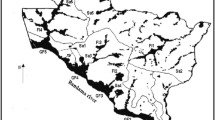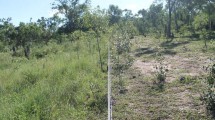Abstract
Africa’s savannas are undergoing rapid conversion from rangelands into villages and croplands. Despite limited research, and evidence of deleterious effects to biodiversity, international organisations have earmarked this system for cropland. Invertebrates, and ants in particular, are sensitive indicators of habitat fragmentation, and contribute to ecosystem services at a range of scales. We investigated how rangelands, villages and croplands differ in ant species and functional diversity, and assemblage composition. We sampled ants using pitfall traps at 42 sites (14 replicates each in rangeland, cropland, and village) in northern South African savannas. We investigated the impact of landuse, season, and multiple soil and vegetation habitat variables on ant species diversity, assemblages and functional diversity. Rangelands had the greatest ant species richness, particularly in the wet season. Richness declined with increasing soil clay content. Ant assemblages were distinctly different between landuse types. Rangeland harboured the widest diversity of indicator species, and contained greatest functional diversity. Rangelands accommodated more scavengers, granivores, and plant-matter feeders than cropland, and representation of these groups varied with season. Ants play essential roles in soil nutrient cycling, plant and seedling recruitment, and impact other arthropods through predation and aphidoculous behaviour that in turn influences entire food webs. Thus, the reduced species richness, changes in assemblage composition and the loss of functional groups in ant assemblages found in cropland and villages is potentially problematic. Left unchallenged, these new forms of landuse threaten to characterise the entire African savanna system, impacting not only future ecological, but possibly also human wellbeing.




Similar content being viewed by others
References
Addison P, Samways MJ (2000) A survey of ants (Hymenoptera: Formicidae) that forage in vineyards in the Western Cape Province, South Africa. Afr Entomol 8:251–260
Andersen AN (1995) Measuring more of biodiversity: genus richness as a surrogate for species richness in Australian ant faunas. Biol Conserv 73:39–43
Andersen AN, Majer JD (2004) Ants show the way down under: invertebrates as bioindicators in land management. Front Ecol Environ 2:291–298
Arcoverde GB, Andersen AN, Setterfield SA (2017) Is livestock grazing compatible with biodiversity conservation? Impacts on savanna ant communities in the Australian seasonal tropics. Biodivers Conserv 26:883–897
Bestelmeyer BT, Wiens JA (2001) Ant biodiversity in semiarid landscape mosaics: the consequences of grazing vs natural heterogeneity. Ecol Appl 11:1123–1140
Boulton AM, Davies KF, Ward PS (2005) Species Richness, abundance, and composition of ground-dwelling ants in Northern California grasslands: role of plants, soil, and grazing. Environ Entomol 34:96–104
Carvalheiro LG, Barbosa ERM, Memmott J (2008) Pollinator networks, alien species and the conservation of rare plants: Trinia glauca as a case study. J Appl Ecol 45:1419–1427
Carvalho FMV, De Marco P, Ferreira LG (2009) The Cerrado into-pieces: habitat fragmentation as a function of landscape use in the savannas of central Brazil. Biol Conserv 142:1392–1403
Christianini AV, Oliveira PS (2010) Birds and ants provide complementary seed dispersal in a neotropical savanna. J Ecol 98:573–582
Coe MJ, Cumming DH, Phillipson J (1976) Biomass and production of large African herbivores in relation to rainfall and primary production. Oecologia 22:341–354
De Cáceres M, Legendre P (2009) Associations between species and groups of sites: indices and statistical inference. Ecology 90:3566–3574
De Cáceres M, Legendre P, Moretti M (2010) Improving indicator species analysis by combining groups of sites. Oikos 119:1674–1684
de Queiroz ACM, Rabello AM, Braga DL et al (2017) Cerrado vegetation types determine how land use impacts ant biodiversity. Biodivers Conserv. https://doi.org/10.1007/s10531-017-1379-8
Del Toro I, Ribbons RR, Pelini SL (2012) The little things that run the world revisited: a review of ant-mediated ecosystem services and disservices (Hymenoptera: Formicidae). Myrmecol News 17:133–146
Delsinne T, Roisin Y, Herbauts J, Leponce M (2010) Ant diversity along a wide rainfall gradient in the Paraguayan dry Chaco. J Arid Environ 74:1149–1155
Fisher BL, Bolton B (2016) Ants of Africa and Madagascar—a guide to the Genera. University of California Press, Berkeley
Flynn DFB, Gogol-Prokurat M, Nogeire T et al (2009) Loss of functional diversity under land use intensification across multiple taxa. Ecol Lett 12:22–33
Foley JA, Ramankutty N, Brauman KA et al (2011) Solutions for a cultivated planet. Nature 478:337–342
Folgarait P (1998) Ant biodiversity to ecosystem functioning: a review. Biodivers Conserv 7:1121–1244
Gerland P, Raftery AE, Ševčíková H et al (2014) World population stabilization unlikely this century. Sciencexpress 387:803–805
GlobCover (2010) The GlobCover 2009 Project. http://dup.esrin.esa.it/globcover/. Accessed 15 Feb 2011. ESA UCLouvain. GlobCover 2009 Proj
Gómez JM (2000) Effectiveness of ants as pollinators of Lobularia maritima: effects on main sequential fitness components of the host plant. Oecologia 122:90–97
Graham JH, Krzysik AJ, Kovacic DA et al (2009) Species richness, equitability, and abundance of ants in disturbed landscapes. Ecol Indic 9:866–877
Greenslade PJM (1973) Sampling ants with pitfall traps: digging-in effects. Insectes Soc 20:343–353
Greenslade PJM, Greenslade P (1977) Some effects of vegetation cover and disturbance on a tropical ant fauna. Insectes Soc 24:163–182
Haberl H, Plutzar C, Erb K et al (2005) Human appropriation of net primary production as determinant of avifauna diversity in Austria. Agric Ecosyst Environ 110:119–131
Henri DC, Jones O, Tsiattalos A et al (2015) Natural vegetation benefits synergistic control of the three main insect and pathogen pests of a fruit crop in southern Africa. J Appl Ecol 52:1092–1101
Hoffman BD, James CD (2011) Using ants to manage sustainable grazing: dynamics of ant faunas along sheep grazing gradient conform to four global patterns. Austral Ecol 36:698–708
Hölldobler B, Wilson EO (1994) The ants. Harvard University Press, Cambridge
Holm E, Scholtz C (2008) Insects of Southern Africa. Protea Boekhuis, Pretoria
Johnson RA (2000) Habitat segregation based on soil texture and body size in the seed-harvester ants Pogonomyrmex rugosus and P. barbatus. Ecol Entomol 25:403–412
Jones CG, Lawton JH, Shachak M (1994) Organisms as Ecosystem Engineers. Oikos 69:373–386
Landis DA, Wratten SD, Gurr GM (2000) Habitat management to conserve natural enemies of arthropod pests in agriculture. Annu Rev Entomol 45:175–201
Lasmar CJ, Queiroz ACM, Rabello AM et al (2017) Testing the effect of pitfall-trap installation on ant sampling. Insectes Soc. https://doi.org/10.1007/s00040-017-0558-7
Lavorel S, Grigulis K, McIntyre S et al (2008) Assessing functional diversity in the field—methodology matters! Funct Ecol 22:134–147
Lobry De Bruyn LA (1999) Ants as bioindicators of soil function in rural environments. Agric Ecosyst Environ 74:425–441
Löhr B (1992) The pugnacious ant, Anoplolepis custodiens (Hymenoptera: Formicidae), and its beneficial effect on coconut production in Tanzania. Bull Entomol Res 82:213–218
McIntyre BD, Herren HR, Wakhungu J, Watson RT (2009) Agriculture at a crossroads. International Assessment of Agricultural Knowledge, Science and Technology for Development (IAASTD): Global report, Washington DC
Mucina L, Rutherford MC (2006) The Vegetation of South Africa, Lesotho and Swaziland. South African National Biodiversity Institute, Pretoria, pp 492–493
Munyai TC, Foord SH (2012) Ants on a mountain: spatial, environmental and habitat associations along an altitudinal transect in a centre of endemism. J Insect Conserv 16:677–695
Munyai TC, Foord SH (2015) Temporal patterns of ant diversity across a mountain with climatically contrasting aspects in the tropics of Africa. PLoS ONE 10:1–16
Nakagawa S, Schielzeth H (2013) A general and simple method for obtaining R2 from generalized linear mixed-effects models. Methods Ecol Evol 4:133–142
Oksanen AJ, Blanchet FG, Kindt R, et al (2016) Package “vegan.” R package version 2.4-3, https://CRAN.R-project.org/package=vegan
Otoshi MD, Bichier P, Philpott SM (2015) Local and landscape correlates of spider activity density and species richness in urban gardens. Environ Entomol 44:1043–1051
Pacheco R, Vasconcelos HL (2012) Habitat diversity enhances ant diversity in a naturally heterogeneous Brazilian landscape. Biodivers Conserv 21:797–809
Parr CL, Robertson H, Biggs HC, Chown SL (2004) Response of African savanna ants to long term fire regimes. J Appl Ecol 41:630–642
Parr CL (2008) Dominant ants can control assemblage species richness in a South African savanna. J Anim Ecol 77:1191–1198
Perfecto I, Snelling R (1995) Biodiversity and the transformation of a tropical agroecosystem: ants in coffee plantations. Ecol Appl 5:1084–1097
Picker MD, Samways MJ (1996) Faunal diversity and endemicity of the Cape Peninsula, South Africa—a first assessment. Biodivers Conserv 5:591–606
Pinheiro J, Bates D (2016) Package ‘nlme’. Linear and Nonlinear Mixed Effects Models. https://cran.r-project.org/web/package/nlme/nlme.pdf
Prins AJ, Robertson HG, Prins A (1990) Pest ants in urban and agricultural areas of southern Africa. In: Van der Meer R, Jaffe K, Cedeno A (eds) Applied myrmecology: a world perspective. Westview Press, Boulder
Riggio J, Jacobson A, Dollar L, Bauer H (2013) The size of savannah Africa: a lion’s (Panthera leo) view. Biodivers Conserv 22:17–35
Salas-Lopez A, Mickal H, Houadria M, Menzel F, Orivel J (2017) Ant-mediated ecosystem processes are driven by trophic community structure but mainly by the environment. Oecologia 183:249–261
Samways MJ (1983) Interrelationship between an entomogenous fungus and two ant-homopteran (Hymenoptera: Formicidae-Hemiptera: Pseudococcidae & Aphididae) mutualisms on guava trees. Bull Entomol Res 73:321–331
Samways M (1990) International association for ecology species temporal variability: epigaeic ant assemblages and management for abundance and scarcity. Oecologia 84:482–490
Styrsky JD, Eubanks MD (2007) Ecological consequences of interactions between ants and honeydew-producing insects. Proc Biol Sci 274:151–164
Styrsky JD, Eubanks MD (2010) A facultative mutualism between aphids and an invasive ant increases plant reproduction. Ecol Entomol 35:190–199
Wagner D, Jones JB, Gordon DM (2004) Development of harvester ant colonies alters soil chemistry. Soil Biol Biochem 36:797–804
Wang C, Strazanac JS, Butler L (2001) Association between ants (Hymenoptera: Formicidae) and Habitat characteristics in oak-dominated mixed forests. Environ Entomol 30:842–848
Wetterer JK (2005) Worldwide distribution and potential spread of the long- legged ant, Anoplolepis gracilipes (Hymenoptera: Formicidae). Sociobiology 45:1–21
Wielgoss A, Tscharntke T, Rumede A et al (2014) Interaction complexity matters: disentangling services and disservices of ant communities driving yield in tropical agroecosystems. Proc R Soc B 281:20132144
Yates M, Andrew NR (2011) Comparison of ant community composition across different land-use types: assessing morphological traits with more common methods. Aust J Entomol 50:118–124
Acknowledgements
We thank the National Research Foundation (NRF), and the Department of Science & Technology (DST) through the South African Research Chairs Initiative (SARChI) Chair on Biodiversity Value and Change in the Vhembe Biosphere Reserve, hosted and supported by the University of Venda. This project was supported by the German Federal Government, BMBF (SPACES programme: Limpopo Living Landscapes Project). Two anonymous reviewers and the handling editor provided constructive and useful criticism.
Author information
Authors and Affiliations
Corresponding author
Additional information
Communicated by Akihiro Nakamura.
Electronic supplementary material
Below is the link to the electronic supplementary material.
Rights and permissions
About this article
Cite this article
Mauda, E.V., Joseph, G.S., Seymour, C.L. et al. Changes in landuse alter ant diversity, assemblage composition and dominant functional groups in African savannas. Biodivers Conserv 27, 947–965 (2018). https://doi.org/10.1007/s10531-017-1474-x
Received:
Revised:
Accepted:
Published:
Issue Date:
DOI: https://doi.org/10.1007/s10531-017-1474-x




